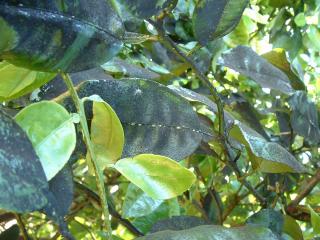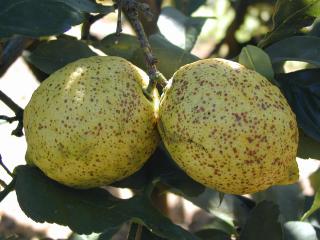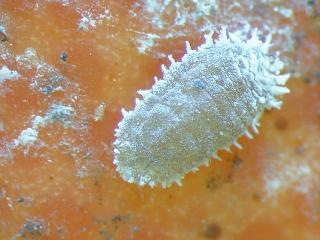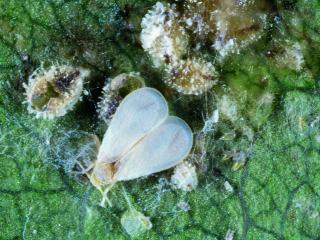Sap-sucking insects
Honeydew producing insects
Scale, mealybug, aphids and whiteflies are closely related species that suck plant juices with specialised mouthparts. Honeydew, a sweet, sticky liquid, is excreted as a by-product of their feeding. The honeydew drips onto leaves, twigs, fruit and furniture, on which the sooty mould establishes.
Although sooty moulds do not infect plants, they can cause indirect damage by interfering with photosynthesis. This can stunt plant growth and coated leaves may also drop prematurely. Fruit covered with sooty mould are edible and the mould can be removed from the fruit with a solution of mild soap and warm water. A horticultural oil will control the insects.
Scales
Scales are unusual insects appearing to lack legs and eyes. Most species are usually only mobile when young and remain stationary on the plant as adult insects. Red scale (Aonidiella aurantii) is a major pest in Western Australian home gardens, infesting leaves, fruit, twigs and limbs. They are attacked by small parasitic wasps including Aphytis melinus and by ladybirds. Control bad infestations with horticultural oil which suffocates the insects.
Other scale pests sometimes seen on citrus trees in Western Australia include soft brown scale (Coccus hesperidum), black scale (Saissetia oleae), citricola scale (Coccus pseudomagnoliarum), white wax scale (Ceroplastes destructor), cottony cushion scale (Icerya purchase) and hard or Chinese wax scale (Ceroplastes sinensis).
A number of different preditors and parasite species have been released in commercial orchards over the years to help control different scale insects indcluding parasitic wasps. Some ladybird species are also predators of scale insects.
Aphids
Aphids are small, 1-3mm, pear-shaped, soft-bodied insects. They can be winged or wingless and are usually slow moving. The black citrus aphid (Toxoptera citricida) is an exotic species commonly found on Western Australian citrus.
Aphids are most abundant when there is new, flushing growth, usually in September/October and February to April. The aphids cluster on blossoms and young shoot growth, causing twisting and distortion. Aphids also excrete honeydew on which sooty mould can grow.
Aphids are attacked by a wide range of naturally occurring beneficial insects including small parasitic wasps, ladybirds, lacewings and hoverfly larvae. For chemical control, a spray containing garlic, chilli and pyrethrins is commercially available as a low toxicity pesticide.
Mealybugs
Mealybugs are coated with a fluffy layer of wax. Two exotic species, citrus mealybug (Planococcus citri) and the long-tailed mealybug (Pseudococcus longispinus), attack Western Australian citrus trees. Mealybugs are up to 3mm long and are found on naval ends and under calyxes of fruit, as well as between touching fruit and leaves. Long-tailed meaybugs have long white ‘hairs’ extending from the tail region, whereas citrus mealybugs do not.
Apart from parasitic wasps, the ‘mealybug destroyer’, a native ladybird species (Cryptolaemus montrouzieri) and lacewing are natural control agents.
Use horticultural oil to control scale or horticultural soap or oil to control aphids and mealy bugs.
Whiteflies
Whiteflies resemble tiny, snowy white moths. The native whitefly, (Orchamoplatus citri), attacks backyard citrus in Western Australia. The adults, eggs, larvae and pupae are often found on the underside of leaves. Native citrus Whitefly is attacked by a range of naturally occurring predators including ladybirds, lacewing, hoverfly larvae and some beetles.
Mites are less than 1mm in size and often tick or spider-like in appearance and adult have eight legs. Species such as two-spotted mite are just visible to the naked eye, while others including the brown citrus rust mite and citrus bud mite can only be seen with the aid of a microscope. In Western Australia, two-spotted mites and citrus bud mites are the most common citrus pests.




